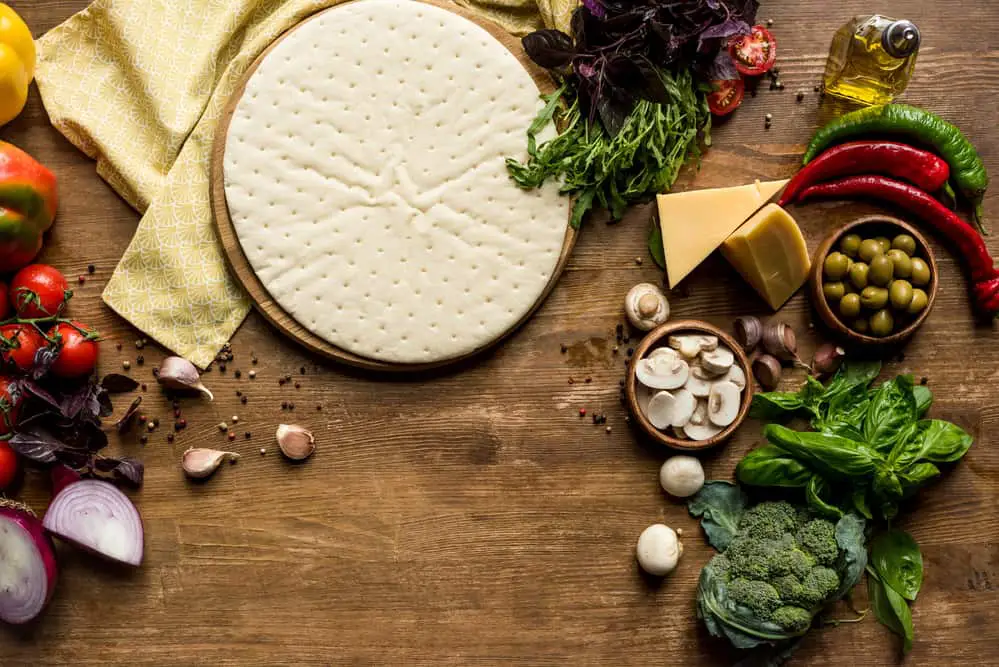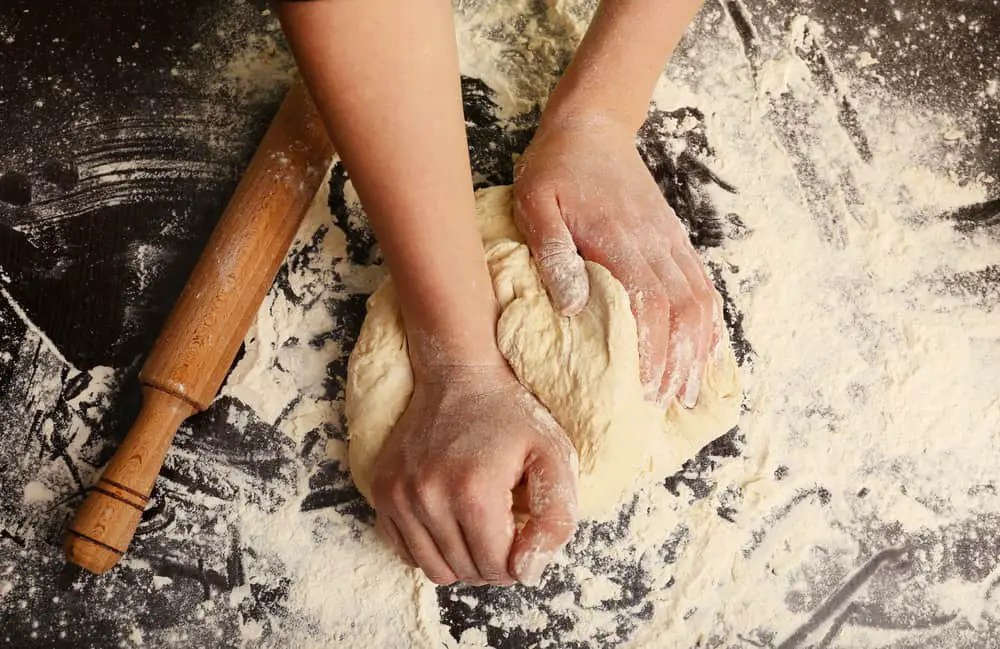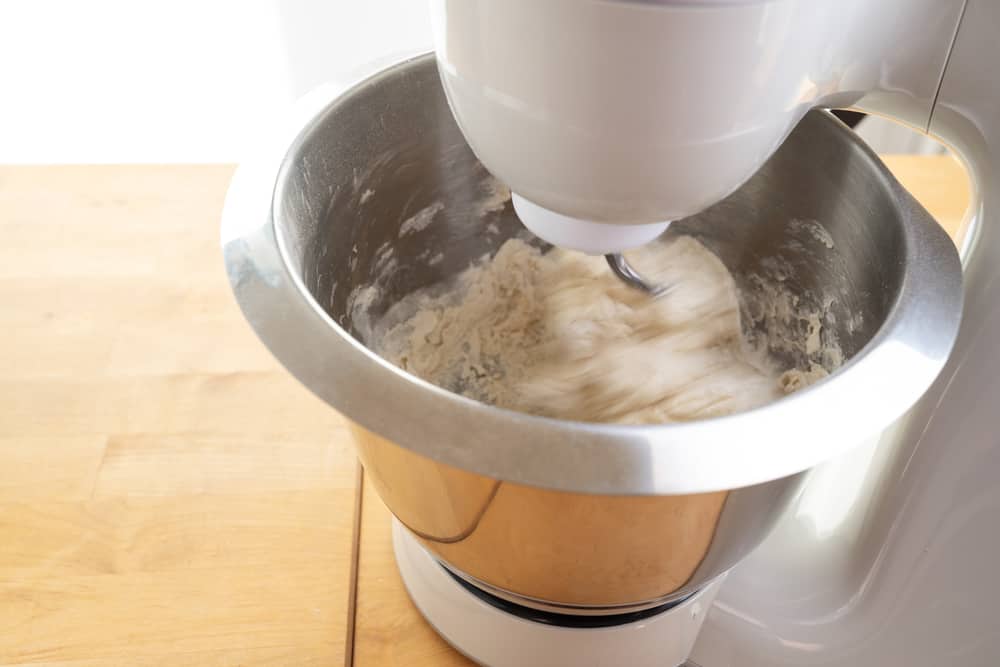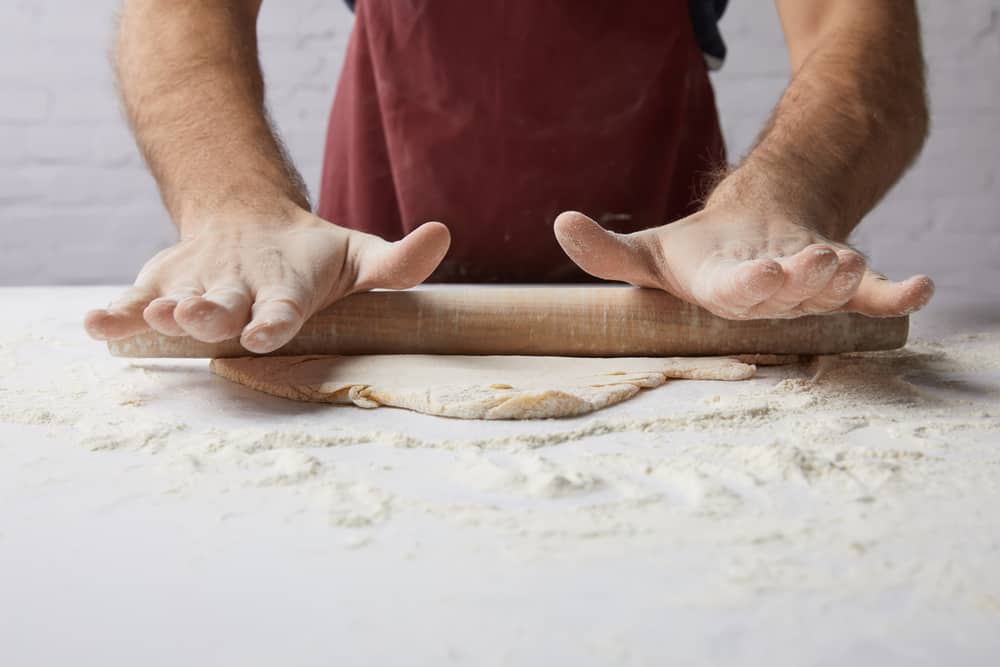Pizza Dough Basics – Everything You Need to Know
If you’re a fan of pizza, then you know that the dough is an important part (many would say the most important part) of the dish. There are many different recipes for pizza dough, and each one has its own set of ingredients and instructions. We want you to enroll in our very own Pizza Dough University. After reading our epic guide, you’ll be an honor graduate for sure!
What are the Ingredients in Pizza Dough?
The ingredients can vary, but most recipes call for flour, yeast, salt, water, and olive oil. These ingredients are combined to create a dough that is soft and easy to work with. Most recipes also call for sugar, which helps to activate the yeast and makes the dough rise.
What’s the Difference Between Pizza Dough and Bread Dough?
The water to flour ratio in pizza dough is lower than in bread dough. Pizza dough also commonly contains oil. In bread dough, the water ratio is generally higher than flour. While both bread and pizza dough contain yeast, different types are used for each. Bread uses active dry yeast, while pizza typically contains instant yeast or fresh yeast.
Both bread and pizza dough are allowed to rise before baking, but the time frame differs. Bread dough typically rises for an hour, while pizza dough only needs 20 minutes. Finally, the salt content is higher in bread dough than in pizza dough. This is because salt helps control yeast activity and gives the bread a better flavor.

How to Proof Pizza Dough
Proofing is the process of allowing the dough to rise before it is baked. This allows the yeast and sugar in the dough to activate, which gives the crust its airy texture and chewy consistency. Do not skip the proofing part when it comes to your dough. Otherwise, you will be left with a dense and heavy crust.
There are several ways to proof pizza dough. One way is to place the dough in a greased bowl, cover it with plastic wrap, and let it rise in a warm place for about an hour. Another method is to shape the dough into a ball and place it on a greased baking sheet. Then, cover the dough with plastic wrap and let it rise in a warm place for about 20 minutes. Once the dough has risen, you can top it with your favorite ingredients and bake it in the oven.
How to Proof Pizza Dough Fast
If you’re in a hurry and need to proof your dough quickly, there are a few shortcuts that you can take. One way is to set the oven at 300°F and let it preheat for five minutes. Then, turn off the heat and place your dough inside with a bowl of water on top; this will create steam that helps your dough rise faster.
Another method is to microwave your dough for about 20 seconds. This will help it rise quickly without losing any of its flavor or texture. Putting the dough in the microwave with a boiling cup of water is one of the simplest methods. The steam from the water will help the dough rise faster.
One more option is to use a bread machine; this will allow you to proof your dough without making any temperature changes. When the bread machine is done with its cycle, simply remove it from the oven and top with toppings before baking as usual.
Proofing Pizza Dough in Oven
The length of time you proof your dough in the oven varies depending on your recipe. The temperature, humidity, and freshness of your yeast will all have an impact. A simple way is to heat your oven at its lowest temperature (typically 200 degrees Fahrenheit.) As your oven heats, note the temperature and turn the oven off at a temperature of 110 degrees Fahrenheit, and put your dough in the oven. Remember to keep the oven turned off and let the dough rest in the oven at a temperature between 80 and 85 degrees which is our desired temperature for proofing the dough.
How Long to Rest Pizza Dough

Pizza dough should rest at least 30 minutes, preferably one hour before shaping. The longer the yeast has to feed, the more flavor your pizza crust will have. This resting time is known as proofing or fermenting, and it gives your dough a chance to expand in size while becoming softer and more flexible. If you have more time, you can increase the resting period by up to 24 hours, which will give your dough a more complex flavor.
How to Make Pizza Dough Rise Faster
You can do a few things to help your dough rise faster. One is to let it rise at room temperature rather than in the refrigerator. That’s because yeast activates faster when it’s warm. The second thing you can do is add a bit more yeast: if your pizza dough recipe calls for one teaspoon of active dry yeast, try adding another ¼ teaspoon, or even ½ teaspoon, of active dry yeast. Finally, you can also add a little sugar to the dough, which will help feed the yeast and make it rise more quickly.
Overnight Dough – Is it a Better Way?
The most obvious benefit of using an overnight pizza dough is that you don’t have to spend as much time in the kitchen on pizza night. You can prepare the dough ahead of time and then just focus on toppings when it comes time to cook. This can be a real lifesaver if you’re short on time or want to get dinner on the table without too much fuss.
Another advantage of using an overnight dough is that it tastes better than store-bought crusts. Most store-bought crusts are full of preservatives to extend their shelf life, which means they’re not as fresh or flavorful. Homemade dough is also less expensive than buying pre-made crusts from the grocery store.
Kneading Pizza Dough
Kneading is the process of working dough by hand. The goal is to develop gluten, make pizza dough stretchy so it doesn’t shrink back when you roll it out, and bake it into a crust with a good chew.
How to Knead Pizza Dough
What makes your pizza dough perfect? The answer is kneading! There are different techniques for kneading, but all of them involve folding the dough over on itself repeatedly until it’s smooth and elastic. You can do this in a bowl or on a work surface dusted with flour. If your dough is wet, you might want to add more flour as you go along to keep it from sticking. Kneading should take about ten minutes. When you’re done, the dough will be soft and pliable.
Rule of Thumb For Kneading Pizza Dough
The kneading process can be shortened by using a food processor with a dough blade or a heavy-duty mixer. Use only enough machine power to create the desired consistency and texture in your pizza dough; over kneading results in tough pizza crusts that are hard to roll out and bake up chewy instead of tender-crisp.
How Do You Knead Dough?
While you have a few options to choose from, there are a few basic steps that you can follow to ensure success. First, it is essential to remember not to overwork your dough. When kneading, you want the bread or pizza crusts to be pliable and easy to work with after they’ve been rolled out and shaped into pans or circles. This means that when you have worked all of the ingredients together until they form a smooth ball that doesn’t stick much anymore (about five minutes), it is time for another step: Rising!
Place your dough in an oiled bowl – olive oil works well – and cover with plastic wrap. Leave it alone for about two hours so that the gluten can develop properly; this helps the dough rise.
Kneading Pizza Dough by Hand

There are four basic steps that you can follow when kneading by hand. First, flatten out your ball of dough onto a lightly floured surface. Next, fold the front edge over until it meets up with the back edge; press down firmly on this seam with your fingers or heel of one palm and push away from yourself so that it stretches slightly (repeat two more times). Then turn the whole thing ninety degrees clockwise before repeating this step – only in reverse!
You should now have eight “corners” where all three sides meet at right angles (four corners if you didn’t do anything fancy like folding it in half). Finally, press all of these seams together before starting the process again.
Do You Have to Knead Pizza Dough?
There is no need to knead pizza dough (need to knead, see what we did there?) if you don’t want to, but it will affect the texture and flavor of your crust. Kneading develops the gluten in the flour. If you don’t want to hassle with all of that, however, you can use a food processor with a dough blade or heavy-duty mixer – just be careful not to overwork the dough.
How Long to Knead Dough by Hand
It is essential not to overwork your dough by hand. Generally, when it comes to time, if you are kneading by hand, it takes about ten minutes until the dough is smooth and elastic. You can do this in a bowl or on a work surface dusted with flour. If your dough is wet, you might want to add more flour as you go along to keep it from sticking.
So, when asking how long should you knead pizza dough, timing is important. You don’t want to overwork the dough, but you also don’t want it to be undercooked. The perfect kneading time will result in a tender and crisp crust. If you are using a stand mixer or food processor, about five minutes on low speed should do the trick; for those opting to use their hands, ten minutes of kneading will ensure good results.
Can You Over-Knead Pizza Dough?
Yep. You can certainly overwork your dough if you’re not careful. Mostly, over kneading results in tough pizza crusts that are hard to roll out and bake up chewy instead of tender-crisp. Generally speaking, when it comes time for the second rise (after shaping), stop kneading and let nature take its course. This is a good indication that there has been enough gluten development without overdone (the longer you let the dough sit before using it again, the more gluten will break down).
How Do I Know When My Pizza Dough is Kneaded Enough?
If you want to make sure your pizza dough is properly kneaded, try stretching some between two fingers until it becomes translucent. Once this happens, the dough is ready to rise or bake immediately.
How to Make Pizza Dough with No Mixer
Making pizza dough without a mixer is not difficult but does require some elbow grease. First, you will need to pour your flour into a large bowl and add salt (if desired). Then make a well in the middle where we can put yeast mixture.
Now comes time for kneading! Knead by hand on a floured surface until the dough is smooth and elastic, which takes roughly ten minutes. Do not overwork or undermix, as either one could result in an inferior crust that doesn’t rise properly during the baking process (this also applies when using machines).
How to Make Pizza Dough with a Kitchen Aid Mixer

A Kitchen Aid mixer will surely make your life easier when kneading pizza dough. You can add all ingredients to the bowl of your mixer and let it knead the dough for you – this will take about five minutes. The best way to tell if the dough is ready is by its texture; it should spring back when poked.
We are big fans here at Daisy Flour of the venerable Kitchen Aid mixer.
How to Make Pretzels With Pizza Dough
If you are looking for a unique way to use up leftover pizza dough, try making pretzels with it instead of throwing them away! First, preheat your oven to 350 degrees Fahrenheit. Then, follow these simple steps:
-Roll the dough out into a large rectangle on a lightly floured surface.
-Brush the dough with some melted butter and then sprinkle it generously with salt and baking soda.
-Cut the dough into 12 strips, then twist each strip into a pretzel shape.
-Place the pretzels onto a greased baking sheet and bake them for 15 minutes or until golden brown.
-Serve them warm with your favorite dipping sauce!
For extra flavor, you can also add shredded cheese, pepperoni slices, or other toppings of your choice before baking them. These pretzels will be sure to please any crowd, and they are a fun and easy way to use up any leftover pizza dough. Enjoy!
How to Make Rolls Out of Pizza Dough
If you have some leftover pizza dough, this recipe is the perfect way to use it up. Just roll out your dough on a lightly floured surface and then cut into small rounds. Next, place those rounds onto greased baking sheets and bake for 15 minutes at 375 degrees Fahrenheit (190 Celsius). Then remove from oven let cool slightly before serving warm with butter if desired. Finally, serve them as an appetizer alongside other tasty treats like pretzels or popcorn balls!
How to Make Pizza Rolls from Pizza Dough
If you want to make pizza rolls from your leftover dough, follow these simple steps:
-Roll the dough out into a large rectangle on a lightly floured surface.
-Spread some tomato sauce over the top of the dough and then sprinkle with mozzarella cheese and your favorite pizza toppings.
-Roll the dough up like a Swiss roll, making sure to seal the edges well.
-Slice the rolls into small pieces and place them onto greased baking sheets.
-Bake at 375 degrees Fahrenheit (190 Celsius) for 15 minutes or until golden brown.
-Serve warm with your favorite dipping sauce!
These pizza rolls are perfect for any occasion, and they are sure to be a hit for both kids and adults alike.
How to Make Flatbread From Pizza Dough

Flatbread is a very versatile type of bread. It can make anything from garlic bread or pita pockets to pizza and even wraps. Luckily there are plenty of ways you can make this delicious treat at home!
The first step in making flatbread from pizza dough is rolling out the dough on a floured surface until it’s about ¼ inch thick or less than half an inch thick, depending on how thin you want your flatbread to be. You can then either use a pizza cutter or knife to cut the dough into squares, triangles, circles, or any other shape you like.
If you’re using an oven, preheat it to 350 degrees Fahrenheit before placing your flatbreads on a baking sheet and cooking them for about 15 minutes or until they are golden brown.
If you want to cook your flatbreads over a stovetop, heat some cooking oil in a frying pan first and then place the bread in the pan. Cook each side of the bread for about two minutes or until golden brown and have small bubbles around their edges. Once they are done, remove them from the heat and enjoy!
How to Make Focaccia With Pizza Dough
Focaccia is a flat Italian yeast bread. It may be topped with herbs or other ingredients and serves as an appetizer, snack, table bread, or sandwich base. To make focaccia with pizza dough, you will need:
-Pizza dough (homemade or store-bought)
-Extra virgin olive oil
-Sea salt
-Fresh rosemary leaves (or other desired herbs)
The first step is to preheat your oven to 375 degrees F. Then, line a baking sheet with parchment paper and set it aside. Next, divide the pizza dough into two equal parts. On a lightly floured surface, roll each piece of dough out into an oval shape that’s about ¼ inch thick. Brush each piece of dough with olive oil and then sprinkle with sea salt and fresh rosemary leaves. Bake in the oven for 20-25 minutes or until golden brown.
How to Roll Out Pizza Dough Without a Rolling Pin
As you can probably guess, the most common way to roll out pizza dough is by using a rolling pin. However, if you do not have a rolling pin at home and you can’t buy one right now, there are some tricks to help you roll out your dough without one.
The simplest option is using your hands to roll out pizza dough. This is a slow option, but it will work in a pinch if you don’t have anything else.
Here’s how:
- Place a large piece of wax paper or parchment paper over your pizza dough ball and sprinkle it with some flour.
- Cover the top of the dough with another piece of wax paper or parchment paper and begin to press down on it with your hands.
- Use a rolling motion to roll the dough out from the center outward.
- Keep floured so that the dough doesn’t stick to your hands. You may need to add more flour if the dough is too sticky.
How to Roll Pizza Dough by Hand Properly
It is very important to have the right tools when rolling pizza dough by hand. You can use a rolling pin, but it is better to use your hands. You can press down on the dough and make it flat using your hands. This is better than using a rolling pin because with a rolling pin; you run the risk of getting your fingers stuck in it when trying to roll out thin layers of dough.
You should start by putting some flour on the counter or table where you will be working. Then take one half-cup ball of pizza dough and flatten it into an oval shape that measures about seven inches long by four inches wide (or whatever size works best for what type of crust). It’s important not to overwork this first layer, so don’t worry about small cracks near edges–these won’t affect how well it bakes! Now with both hands on opposite sides of the flattened dough, push them down firmly while rolling back and forth as if you were making a snake out of Play-Doh or clay.
The goal here is to create an even layer without any lumps or bumps; it should look like one big pancake when done correctly! Finally, use a pizza peel or the back of a baking sheet to transfer your rolled-out dough straight on top of an oiled (or non-stick sprayed) pizza pan. This method is a little more challenging than using a rolling pin, but it will give you the most consistent results in terms of thickness and shape.
How to Flatten Pizza Dough

There are a few ways to do this, but the most common is to use a rolling pin. Place your dough on a lightly floured surface and roll it out until it’s about ½ inch thick. Then, use a pizza cutter to cut it into the shape you want. You can also try using a pasta maker to flatten your dough.
Start by rolling it out into a thin sheet, then run it through the widest setting on your machine. Keep folding it over and running it through the machine until it’s about ⅛ inch thick. Finally, you can use a fork to press down on the dough until it’s flat. This is the easiest method, but it takes the longest amount of time.
How to Roll Pizza Dough Without Flour
When you want to roll pizza dough without flour, you can use a few different methods. One way is to roll it out between two pieces of parchment paper. This will help keep the dough from sticking to the rolling pin or countertop. You can also try using a silicone baking mat instead of parchment paper. This will help the dough from sticking and make cleanup a breeze.
You can also try using a silicone rolling pin to make cleanup more difficult, but it’s easier to roll the dough out. Finally, you might want to use an oiled surface (like olive oil) if none of these options work for you! You could even just spray some cooking spray onto your countertop before putting down the dough and rolling away!
How Thin to Roll Pizza Dough
When rolling out pizza dough, you want to roll it thin enough so that the crust is crispy but not so thin that it becomes too brittle and cracks. The best way to determine how thin to roll your dough is to experiment a little bit and see what works best for you. Some people like to roll their dough very thin, while others prefer a slightly thicker crust. Ultimately, it’s up to you how thin or thick you want your pizza crust to be. Just make sure to roll it out evenly so that the entire crust is equally crispy.
How to Make Flaky Pizza Dough
Making flaky pizza dough takes practice, but it’s worth the effort. Here’s how to make it.
-Start by mixing the flour, salt, and sugar in a large bowl.
-Add the butter and use your hands to combine it with the flour mixture until it resembles coarse crumbs.
-Slowly add in the ice water, one tablespoon at a time, until the dough just comes together. Do not overmix!
-Turn the dough onto a floured surface and shape it into a ball.
-Refrigerate for at least 30 minutes before using (this is optional but will help make your crust extra flaky).
-Roll out the pizza dough on a lightly floured surface and place it in a greased pizza pan.
-Preheat the oven to 425 degrees F and bake for 12-15 minutes or until the crust has browned.
How to Make Chewy Pizza Dough
Chewy pizza dough is perfect for those who love a soft, doughy crust on their pizza. This recipe is easy to follow and will give you the perfect chewy crust every time.
Ingredients:
-14 ounces warm water
-½ teaspoon sugar
-¼ ounce active dry yeast (about two and one-quarter teaspoons)
-16 ounces all-purpose flour, plus more for dusting
-⅛ teaspoon salt
-Extra virgin olive oil or vegetable oil for coating the bowl
Directions:
In a large mixing bowl, dissolve the sugar in the warm water. Sprinkle in the yeast and let it sit for about five minutes until foamy. Add in the flour and salt and mix with your hands until everything is incorporated. Knead the dough on a floured surface for about three minutes until it’s smooth and elastic (if you have a stand mixer with a dough hook attachment, use this instead). Put the dough in an oiled bowl and turn to coat all sides of the ball. Cover with plastic wrap or a damp kitchen towel and let sit at room temperature for one hour or overnight in the fridge.
When you are ready to make pizza, preheat your oven or grill as high as it will go (at least 500°F/260°C) before shaping your pizzas—this way, they won’t stick when cooked! If you want more toppings than just sauce and cheese, par-cook your toppings before putting them on the pizza.
Shape the dough into two rounds and place on a lightly floured baking sheet or pizza peel. Top with sauce, cheese, and your favorite toppings, then bake in the oven or grill for 12-15 minutes, until crust is golden brown and cheese is bubbly.
Don’t Make Pizza Crust Too Chewy
While chewy pizza crust can be delicious, it’s not always what you want. One reason you should avoid the crust that is too chewy is that it will be very hard on your teeth. Another reason why you should avoid chewy pizza crust is that it might have too much yeast in it, which can cause indigestion problems for some people.
How to Make Fluffy Pizza Dough

To make fluffy pizza dough, follow these steps:
– In a large bowl, combine the water, yeast, and sugar. Let it sit for about five minutes until bubbles form on the surface.
– Add olive oil to the mixture and mix well using a spoon or spatula.
– Add salt and flour one cup at a time while mixing continuously with your hands until the dough begins to form. Let rest for 30 minutes before rolling out into the desired shape.
How to Make Spongy Pizza Dough
A spongy pizza dough is a light, smooth, and soft kind of dough. This type of pizza dough can be made by following these simple steps: First, mix the flour with salt in a bowl. Second, add yeast and water, then stir until it forms a sticky dough. Third, knead the mixture on a floured surface until smooth and warm (about 15 minutes). Fourth, place the mixture in an oiled bowl covered loosely with plastic wrap or damp cloth for about one hour. Finally, divide the dough into two parts, roll it out on a lightly floured surface, and place it on a greased pizza pan.
Likewise, if you want to know how to make crispy pizza dough, the process is quite similar to making spongy pizza dough. It is just that you will add more flour into your mixture and knead it until smooth. For those who wonder how to make puffy pizza dough, it is a simple process of adding yeast to the dough, letting it rise for at least 30 minutes before baking.
Some Quick Pizza Tips
How to Make Pizza Dough Stretchy
Simply adding a little olive oil to your pizza dough will make it much more stretchy. This is because the added oil will help lubricate the gluten strands, making them less likely to stick together and form tough patches.
How to Make Pizza Dough Not Stick
Adding a little flour to your pizza dough will help to prevent it from sticking to the surface or your hands. This is because the flour will create a thin coating on the outside of the dough, which will keep it from sticking.
How to Make Square Pizza Dough
If you want to make a square pizza, all you need to do is roll out the dough into a rectangular shape before transferring it to your baking sheet.
How to Make Airy Pizza Dough
Making your pizza dough with a high gluten content will help to create an airy texture. This is because the gluten will form elastic strands that trap air pockets as the dough cooks.
How Much Pizza Dough Do I Need?

Whether it is a 12 inch, 14-inch, or 16-inch pizza, the quantity of pizza dough you will need will vary. Keep in mind to always have some extra dough if your pizza is a little bigger than anticipated.
Pizza Yeast – Things to Know
Pizza yeast is designed for making pizza dough. It is active yeast, which means that you can use it straight out of the sachet or jar. You don’t have to ‘proof’ it like baker’s yeast to activate it before using it in a recipe.
Which is the Best Yeast For Pizza?
That is debatable; however, for most people, the best yeast for a pizza is one that produces the best results in terms of flavor and texture. Using fresh yeast achieves this goal. However, some people prefer dry yeast because it is easy to use and lasts for a long time.
Active dry yeast is a fast-rising, high-quality strain of yeast that has been specifically selected for making pizza dough.
How to Use Fresh Yeast in Pizza Dough
If you are using fresh yeast, crumble it into a small bowl and add warm enough (not hot) water to dissolve it. If you are using instant yeast, there is no need to dissolve it in any liquid. Instead, just sprinkle it on top of the flour.
How Much Fresh Yeast for Pizza Dough Is Sufficient?
If you are making pizza dough by hand, you can easily use three ounces of fresh yeast (85 g) to make a batch of dough. You will need about the same amount of instant yeast if you use it for pizza dough by hand.
If you make pizza with a mixer, two ounces of fresh yeast is enough. However, if you’re using active dry or instant yeast, you will need about one ounce of each.
How to Use Dry Yeast in Pizza Dough
The easiest way to use dry yeast is by dissolving it in warm water before adding it to the dough. You can also sprinkle active dry or instant yeast on top of the flour and mix them with your hands until they are well combined. Just make sure that you don’t get any lumps of undissolved sugar leftover, or your dough will not rise properly.
How Much Dry Yeast for Dough is Sufficient
If you are making pizza dough by hand, you can use about two and a half teaspoons of active dry yeast (or one-fourth ounce/seven grams) to make a batch of dough. However, you will need less instant yeast than active dry yeast-about one and a half teaspoons of instant yeast (or three-fourths ounce/21 grams) for every two and a half teaspoons of active dry yeast. If you use a mixer, use one and fourth ounces (36 grams) of instant yeast or the equivalent in active dry yeast.
How to Make Pizza Dough With Wild Yeast
If you are using wild yeast, you will need to start the fermentation process a day or two before you plan to make your pizza. Mix one cup of all-purpose flour, one teaspoon of sugar, and one cup of lukewarm water in a large bowl. Stir in three tablespoons of grapeseed oil and two teaspoons of salt. Then add enough additional flour so that the dough is easy to handle. Knead the dough for about ten minutes or until it is smooth and elastic.
Place it in a greased bowl, cover it with a damp cloth, and set it in a warm place to rise until doubled in size-this will take about an hour. Punch down the dough and divide it into two parts. Roll one part out on a floured surface to make the pizza crust, and roll out the other to use as your topping. Bake at 425 degrees F (220 degrees C) for 15-20 minutes or until golden brown; cool before cutting into slices.
Does Pizza Dough Taste Yeasty?
If you use good quality yeast and follow instructions for the recipe, your pizza dough should not taste too yeasty. However, some people prefer their pizza crust to have more of a sourdough flavor than others; if this describes you, you may want to try making your own from scratch with wild yeast or add some sour cream or yogurt to the recipe.
How to Store Your Dough

If you have time, let the pizza dough rest at room temperature for about 30 minutes before storing it in the fridge. This will help the gluten strands relax and make the dough easier to work with. The best way to store pizza dough is in the refrigerator. You can do this by wrapping your pizza doughs in plastic wrap and storing them on a plate or container for at least 24 hours before using it.
If you make more than one batch of pizza dough, you should use different plates or containers because they will have different rising times. If you are making pizza within the next few hours, you can store your dough in a bowl covered with plastic wrap and a damp towel on top. This will help keep the dough from drying out.
How to Store Homemade Pizza Dough
If you have made a large batch of pizza dough, you can store it in the freezer. Just make sure that you wrap your dough tightly in plastic wrap and then put it in a sealed baggie or container. You can freeze the pizza dough for up to three months. Then, when you are ready to use it, let the dough thaw overnight in the fridge and then let it rise to room temperature for a couple of hours before using it.
How to Store Store-Bought Dough
If you buy your pizza dough from the grocery store, it will likely be in a plastic wrapper. You can just keep this wrapped up until you need to use it but make sure that you take the time to let it rise at room temperature before using it.
If you want an easier way of storing store-bought pizza dough, you can store it in the freezer. Just make sure that you wrap your dough tightly in plastic wrap and then put it in a sealed baggie or container. When you are ready to use it, let the dough thaw overnight in the fridge, and then let it rise to room temperature.
How Long Does Fresh Pizza Dough Last?
Fresh pizza dough can last in the refrigerator for up to four days. If you’re not going to use it in the next few days, wrap it tightly in plastic wrap and store it in a sealed baggie or container before freezing. If you are wondering how long does pizza dough lasts in a freezer, the answer is that it is usually good to stay in there for up to three months.
As for how long the dough can last in the fridge, it depends on what type of dough you are using and how fresh it is. Generally, it can last for up to four days. For old pizza dough, it can last for up to two weeks.
How Long Does Old Pizza Dough Last?
It depends on the state and temperature of the dough, but generally, it can last for up to two weeks. If the dough is older, it is best to freeze it. This will help keep the dough from going bad.
Beware though and don’t push your luck!
How to Prepare Store Bought Dough
You can prepare store bought pizza dough in many ways. One way is to simply flatten the dough with your hands. Sometimes you can also roll it out using a rolling pin so that it’s easier to manage. Another method to prepare store bought pizza dough is to preheat the oven and place the dough on a baking sheet. Finally, you can also use your hands to stretch out the pizza dough into the desired shape.
How to Make Store Bought Dough Better
The best way to make store-bought dough better is to let it sit out for a little bit before you start working with it. This will help the dough warm up and become more pliable, making it easier to work with. Another thing that you can do is add some extra ingredients to the dough. For example, you could add some herbs to give some extra flavor. You could also add cheese on top of the dough before you bake it, which will make it taste even better!
How to Bake Ready-Made Pizza Dough

If you have pizza dough ready to use, that’s great! Then you can skip steps to make pizza dough at home and start baking right away.
First, choose a baking sheet or pan for the dough. It can be square or round, metal or glass; it doesn’t matter as long as it fits in your oven and is sturdy enough for handling hot pizzas; after that, prepare the baking sheet by coating it with cooking spray or olive oil. This will prevent the dough from sticking to the pan and easier removal when done.
Next, take your ready-made dough and place it in the center of your baking sheet. Now stretch and press the dough out to the edges of the pan. If it shrinks back, let it rest for a minute or two until it’s more cooperative. Then use your fingers or a fork to make indentations all over the surface of the dough. This will help it puff up and create those nice little air pockets. Finally, spread your favorite sauce over the surface of the pizza dough. You can use a spoon or just pour it on from the jar.
Don’t be shy with the sauce! Bake it in a preheated oven at 425 degrees for about 15-20 minutes or until the crust is golden brown and the cheese is melted and bubbly.
